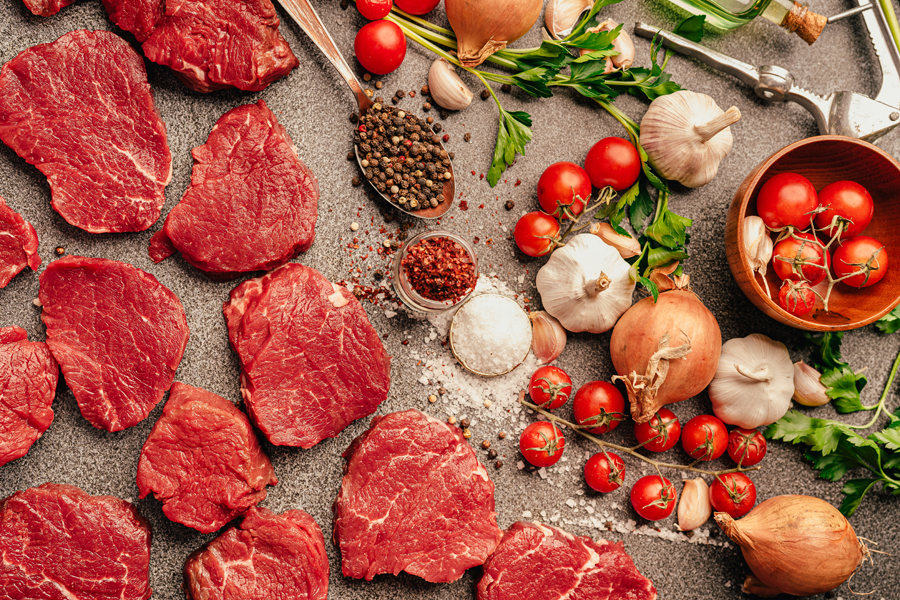
Advantages Of Grass-Fed Meat
With more people looking for healthier alternatives, grass-fed red meat is surely worth considering. Here’s a closer look into the benefits of making this your primary source of protein:
1. Safe to Eat
Grass-fed red meat like Silver Fern Farms’s grass-fed beef & lamb range and other trusted sources come from cattle raised the old-fashioned way. Out in the open grazing grounds, cows, lamb, and goats roam and feed on these greener pastures freely. Farms doing this are proud to label their meat as ‘100% grass-fed.’
In the United States, such a distinction is vital for consumers. The US Department of Agriculture (USDA) currently hasn’t set any criteria for labeling meat as grass-fed yet. In several cases, the term can also mean cattle feed on grass but only as a part of a mostly-grain diet. In others, cattle grazed on grass for a short time, typically up to nine months in their lives, also qualify.
Most of the time, 100% grass-fed products also come with other ethical farming practices. For example, farmers don’t raise their cattle in feedlots where they’re confined until they reach slaughter weight or they don’t inject them with antibiotics, which has been a health concern for years.
2. Packed with Nutrients
Meat has nearly every nutrient a human needs, specifically protein and fat. But how much of these nutrients they can provide differs between grass-fed and grain-fed meat. Below are the numbers based on a 100-gram serving of ground beef from the USDA’s website:
- Grass-fed: 198 calories, 12.73 grams of fat, 19.42 grams of protein
- Grain-fed: 247 calories, 19.07 grams of fat, 17.44 grams of protein
Breaking down the fat content for the two:
- Grass-fed: 34 g saturated, 4.80 g monounsaturated, 0.53 g polyunsaturated
- Grain-fed: 29 g saturated, 8.48 g monounsaturated, 0.51 g polyunsaturated
The difference is significant at a glance because grass-fed meat is leaner and contains more protein for fewer calories and fat. Any bodybuilder will tell you getting enough protein isn’t easy as they usually have many calories. Eating 100 grams of ground grass-fed meat can spare them nearly 50 extra calories for an additional 2 grams of protein. These can be packed using a food vacuum sealer. Please let me know when the link is added.
As for fats, the most important thing to understand is unsaturated fats are good, saturated fats are good in moderation, and trans fats are bad. Grain-fed meat has a slight advantage in unsaturated fats, but grass-fed meat can keep your saturated fat intake in check. The latter also has an advantage in containing more omega-3 fatty acids, which is beneficial for the heart.
Keep in mind, the nutrition content can vary by the type and breed of livestock and the cut of meat. Veal, which is beef from younger cows, is slightly leaner with 24.8 grams of protein and 1.5 grams of fat in a 100-gram serving.
3. Environmentally Friendly
Cattle farming has been on the center stage of a major environmental issue—climate change. With the demand for meat on the rise, farmers have to make more room to expand their herds. However, unadulterated vegetation has to make way for grazing grounds. You’ve probably heard of ranchers in several countries clearing vast swathes of forests to improve meat production.
Many meat-eaters will be the first to admit the environmental impact of eating such food. According to Frank Mitloehner, an air quality specialist at the University of California Davis, the almost-100 kg of methane cows let loose every year remains in the atmosphere shorter than carbon dioxide but is nearly 30 times better in trapping heat.
Because of this, the advocacy of eating less meat—if not forgoing it altogether—has been insistent in recent years. But as Mitloehner also stated, livestock efficiency has dramatically improved since the 1970s. Instead of breeding more cattle for less meat, farmers are now breeding fewer cattle for more meat.
Grass-fed cattle farmers contribute to the solution by what scientists call soil carbon sequestration. By moving the cattle from one grazing ground to another without depleting the forage, local flora and fauna can remain intact and pull carbon dioxide from the atmosphere. The longer the grazing ground gets to regrow, the more plants can store carbon dioxide.
Cattle farms in Australia and New Zealand enjoy the benefit of having plenty of grassland for their herds, that’s why quality grass-fed meat mostly comes from these countries.
4. Works With Most Diets
Grass-fed meat is nutritious to the extent of it working with most diet plans. According to the Self Nutrition Data website, aside from lean protein and fat, a 214-gram grass-fed strip steak can provide:
- 3 mg of niacin (72% Daily Value or DV)
- 4 mg of Vitamin B6 (70% DV)
- 1 mcg of selenium (64% DV)
- 7 mg of zinc (52% DV)
- 7 mcg of Vitamin B12 (45% DV)
- 454 mg of phosphorous (45% DV)
- 4 mg of iron (22% DV)
Among the diets synergizing with grass-fed meat are keto, paleo, and Whole30. Here are some additional details:
- Keto diets drop carbohydrates in favor of fats. While grass-fed meat has less fat than grain-fed meat, as explained earlier, it contains more high-quality fats like omega-3.
- Paleo diets involve meals heavy in protein and veggies, just as hunters and farmers in old times used to eat. Grass-fed meat brings exceptional taste to stews.
- Whole30 diets forbid processed foods, alcohol, and tobacco in their 30-day diet programs. Grass-fed meat is preferred for this diet plan.
There are plenty of good things to say about grass-fed meat. It’s slowly becoming the norm as people look for ways to build their overall health and be more resilient to future outbreaks. Try at least a slab or two and feel the difference for yourself.
Comments
comments